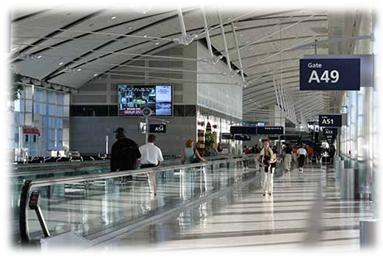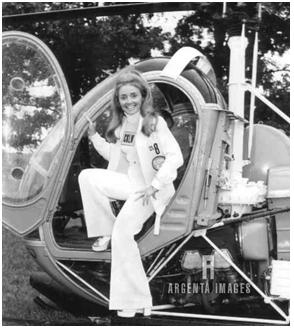Remember those amazing Airport movies back in the ‘70s? They were the start of the big disaster, star-studded blockbusters that spawned a whole new genre of drama films.
Over the next few weeks, many of you will be experiencing your own airport dramas as you’ll be flying around the country visiting friends and relatives. For us consultants and researchers, it is what we regularly undergo as we crisscross America’s airports, going from Point A to Point B just about every week.
Some of you remark to me, “I don’t know how you do it” after they complete a typical airport experience. And as we know, there is a major difference between airports, and the conveniences, services, and restaurants they offer, from Newark to Hartsfield to O’Hare. Those of us who travel incessantly often use those three letter codes to discuss, laud, and complain about one airport or another, from SFO to LAX to LGA.
 So let’s talk about DTW – my hometown hub here in Detroit – for a moment. Since hosting DASH in October, I have heard from a number of attendees who enjoyed the conference, but were especially impressed with the look, feel, and services of Detroit’s Metropolitan Airport. DASH took place at the beautiful Westin, embedded in Delta’s beautiful McNamara terminal, allowing for a smooth, seamless, experience.
So let’s talk about DTW – my hometown hub here in Detroit – for a moment. Since hosting DASH in October, I have heard from a number of attendees who enjoyed the conference, but were especially impressed with the look, feel, and services of Detroit’s Metropolitan Airport. DASH took place at the beautiful Westin, embedded in Delta’s beautiful McNamara terminal, allowing for a smooth, seamless, experience.
Now if you visited Detroit or changed planes there back in the ‘80s and ‘90s, you very likely suffered through a very different experience. The old terminals were awful, the delays were brutal, the service was beyond bad, and if it could go wrong, it often did.
Delta’s McNamara terminal opened in early 2002, and the Westin was one of its highlights. The terminal is beautiful, efficient, and actually a fun places to visit. I can tell you that while TSA experiences vary widely from airport to airport, Detroit stands out as one of the very best at getting you through the system quickly, courteously, and painlessly.
And if you’ve seen many of the Delta television commercials over the past couple of years, you’re looking at the Detroit Delta terminal featured in many of the shots (even baggage claim).
But one of the most talked about aspects of this airport is a phenomenon that has application to what we all do for a living – and that’s the ability to take something otherwise run of the mill and turn it into something special.
That’s the case with the long hallway that connects Delta’s main A terminal with the smaller B and C concourses that house smaller, regional jets. It could have simply been just another low-ceilinged pathway with moving sidewalks or even mundane trains like you experience in many airports, like Atlanta and Denver. There’s just nothing fun or special about moving from one terminal to the other, and you can see that reflected on the faces of travelers as they go through the motions to reach their desired gates.
But at DTW, Delta customers are amazed and even enchanted by the “Light Tunnel” (or as I call it, “The Pink Floyd Pavilion”). Imagine a sleek, eye-popping, and memorable concourse that is so unique that visitors routinely take pictures and video, and ooh and ah as they move from one terminal to the other. Designed by Mills James Production with glasswork by locally owned Fox Fire Glass Works, the light/sound experience is accompanied by original music composed by Victor Alexeeff.
Here’s a clip from this sensory experience from YouTube (and it’s one of hundreds of videos that consumers have posted there) of this amazing airport feature. It’s more evidence that points to how this simple concept encourages busy, hassled travelers to stop for a moment, and take out their smartphones to capture the experience and share it with friends. That’s what it means to be remarkable.
>Email Recipients: Click here to watch Detroit Metro Light Show<
Broadcasters back in the day were more attuned to these types of ear-catching things, especially in morning radio when it seemed like many stations were doing full-service shows in the drives. As you moved across the radio dial, almost every station did news, weather, sports, and traffic.
So how could you set your show apart? Back when I first started working for Frank Magid, we did research for Bonneville’s KMBZ, one of those big MOR stations with personalities everywhere. But across the street was WDAF, and I vividly recall just how well their traffic tested.
It was the Sky Spy, and the guy’s name was John Wagner who routinely called out motorists for blocking freeways, and injected real personality into his traffic reports. Sky Spy was a bona fide personality, proving that a mundane, utilitarian service like traffic could be fun, memorable, and of course, highly sponsorable. Listeners talked about the Sky Spy and looked forward to the reports whether they were stuck on a freeway or not.
I’m sure many of you can recall a highly memorable traffic reporter in a city or town where you worked and lived – a necessity for standing out in the highly competitive world of drive time radio.
Fast-forwarding to 2013, radio’s ability to deliver traffic that matters to consumers is already being tested by satellite radio and other telematics services that provide accurate traffic at the touch of a button. Even “traffic & weather at the 8’s” stations will be hard-pressed to stand out in the not-so-distant “connected car” future.
 That is, unless they’ve got someone flying above the city, calling out bad drivers, making bad jokes, with a memorable name, and having a schtick like The Big 8’s Jo-Jo Shutty (pictured), Richmond’s Captain Fuzzo, or Darryl Dahmer (who recently celebrated his 40th anniversary with Rogers Radio in Toronto). These radio traffic personalities had the ability to take something very unremarkable – like even an airport concourse – and turn it into an event that was fun, exciting, and buzz-worthy.
That is, unless they’ve got someone flying above the city, calling out bad drivers, making bad jokes, with a memorable name, and having a schtick like The Big 8’s Jo-Jo Shutty (pictured), Richmond’s Captain Fuzzo, or Darryl Dahmer (who recently celebrated his 40th anniversary with Rogers Radio in Toronto). These radio traffic personalities had the ability to take something very unremarkable – like even an airport concourse – and turn it into an event that was fun, exciting, and buzz-worthy.
Radio’s ability to provide personality, a local vibe, and a fun, memorable experience is already being challenged by the myriad of services, platforms, and outlets trying to do their own brand of audio infotainment.
We can learn lessons from a creative airport authority and the crazy traffic reporters back in the ’70s and ’80s.
Yes, even an airport concourse can create a purple cow moment.
Note: The original post stated that Charles Gray was Sky Spy. A couple of Kansas City radio guys have informed that in fact, it was John Wagner. The post has since been corrected. Apologies to anyone and everyone I may have misrepresented.
- What To Do If Your Radio Station Goes Through A Midlife Crisis - April 25, 2025
- A 2020 Lesson?It Could All Be Gone In A Flash - April 24, 2025
- How AI Can Give Radio Personalities More…PERSONALITY - April 23, 2025




Wow! Great tunnel, Fred! High cume…but literally NO TSL, though. 😉
True that, but great word of mouth! Thanks, JC.
Fred,
You have the Sky Spy phenomenon right, but John Wagner was Sky Spy and Charles Gray was the News Director, a well know personality in his own right. I got to KMBZ in 1988 and remember reading the Magid researh. Bonneville also had me take the interesting plane trip to Marion to sit with the analysts and understand the research. That kind of commitment to quality information and detail, plus the encouragement by ownership to learn, grow and be the best, made Bonneville a grand career experience!
Thanks for the correction, Brad. I will put an addendum on the post. So you saw the cornfields of Marion, Iowa, eh? It was smart of them to invest in your “education.” Research back then wasn’t as sophisticated as it is today, but stations that committed to it had a decided edge. Thanks again.